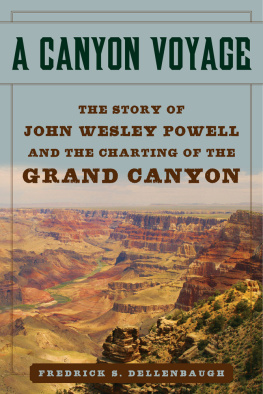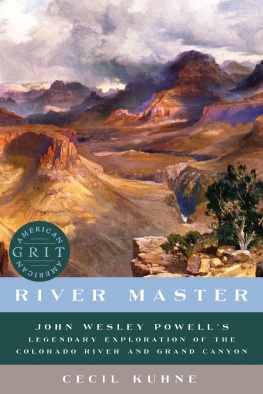

DOWN THE GREAT UNKNOWN. Copyright 2001 by Edward Dolnick. All rights reserved under International and Pan-American Copyright Conventions. By payment of the required fees, you have been granted the non-exclusive, non-transferable right to access and read the text of this e-book on-screen. No part of this text may be reproduced, transmitted, down-loaded, decompiled, reverse engineered, or stored in or introduced into any information storage and retrieval system, in any form or by any means, whether electronic or mechanical, now known or hereinafter invented, without the express written permission of HarperCollins e-books.
EPub Edition SEPTEMBER 2001 ISBN: 9780061760341
Print edition first published in 2001 by HarperCollins Publishers, Inc.
10 9 8 7 6 5 4 3 2 1
TO RUTH AND LYNN, THE GIRLS IN MY LIFE
CONTENTS
We are now ready to start on our way down the Great Unknown... We are three quarters of a mile in the depths of the earth... We have an unknown distance yet to run; an unknown river yet to explore. What falls there are, we know not; what rocks beset the channel, we know not; what walls rise over the river, we know not. Ah, well! We may conjecture many things. The men talk as cheerfully as ever; jests are bandied about freely this morning; but to me the cheer is somber and the jests are ghastly.
John Wesley Powell, August 13, 1869
August 30, 1869, the Colorado River at the foot of the Grand Canyon
The fishermen kept their gaze focused intently on the river, but it was not fish they were looking for. A splintered plank from a broken boat, a torn shirt, perhaps a lifeless bodythese were the fragments or relics they had been instructed to watch for.
Only a few miles upstream, six exhausted men in two boats pushed themselves into the current. Ragged, half-starved, burnt black by ninety-eight days in the desert sun, the men were in sorry shape. Explorers who dreamed of gold and glory, they had been given up for dead weeks before. Fearful Disaster, the Chicago Tribune had trumpeted on its front page on July 3. The entire party, save one man, had been Engulfed in a Moment.
But they have not drowned. They are still alive, barely, still hoping they have food and strength enough to grope their way to safety.
THE CHALLENGE
Noon, May 24, 1869
The few inhabitants of Green River Station, Wyoming Territory, gather at the riverfront to cheer off a rowdy bunch of adventurers. Ten hardy men in four wooden boats had spent the morning checking their gear and their provisions one last timebacon, flour, coffee, spare oars, sextants and barometers (their leader, the skinny, one-armed man in the Emma Dean, fancied himself a scientist). Their plan could hardly be simpler. They will follow the Green River downstream until it merges with the Grand to become the Colorado, and then they will stay with the Colorado wherever it takes them. They intend in particular to run the river through the fabled chasm variously called Big Canyon or Great Canyon or Grand Canyon, a region scarcely better known than Atlantis. No one has ever done it.
The men hope to make their fortunes; their leader plans to emblazon his name across the heavens. They are brave, they have new boats and supplies to last ten months, they are at home in the outdoors. Most important, they are ready to risk their lives.
At one oclock, the Emma Dean, the Kitty Clydes Sister, the Maid of the Caon, and the No Name push themselves out into the current. A small American flag mounted on the Emma Dean flaps proudly in the breeze. Most of the crew are still a bit bleary-eyed. As a farewell to civilization, they have done their best to drink Green River Stations only saloon dry. Now they are suffering what one of them describes as foggy ideas and snarly hair. The small crowd gives a cheer, the leader doffs his hat, and the four boats disappear around the rivers first bend.
John Wesley Powell, the trip leader, was a Civil War veteran who had lost his right arm at Shiloh. Thirty-five years old and unknown, Powell was a tenderfoot who barely knew the West, a geology professor at a no-name college, an amateur explorer with so little clout that he had ended up reaching into his own (nearly empty) pocket to finance this makeshift expedition. His appearance was as unimpressive as his rsumat 5 feet, 6 1/2 inches and 120 pounds, he was small and scrawny even by the standards of the age, a stick of beef jerky adorned with whiskers.
To Powell, a natural leader, all that was unimportant. Overflowing with energy and ambition, he was a man of almost pathological optimism. With a goal in mind, he was impossible to discourage.
He had devised an extraordinary goal. In 1803, with the full and enthusiastic backing of the president of the United States, Lewis and Clark had opened the door to the American West. In 1869, with almost no government support, John Wesley Powell intended to resolve its last great mystery. By this time, the map of the United States had long since been filled in. For two centuries, Boston had been a center of learning and culture. New York and Philadelphia were booming, Nashville and New Orleans struggling to recover from the Civil War. Californias gold rush was almost a generation in the past. In May 1869, the pounding of a ceremonial spike at Promontory Summit, Utah, marked the completion of the transcontinental railroad.
The Rockies and the Sierra Nevada and Yosemite and Death Valley were old news. Miners in search of gold, trappers in quest of beavers whose pelts could be transformed into hats for London dandies, a host of government and railroad surveying parties, all had crisscrossed one anothers steps in even the most isolated spots of the American continent.
Except one. One mystery remained. In the American Southwest an immense areaan area as large as any state in the Union, as large as any country in Europeremained blank. Here mapmakers abandoned the careful notations that applied elsewhere and wrote simply unexplored. Venturesome Westerners knew that the region was desolate and bone-dry; they knew the Colorado River ran through it; they knew that canyons cleaved the ground like gouges cut by a titanic axe. Beyond that, rumor would have to do. Men whispered tales of waterfalls that dwarfed Niagara and of places where the mighty Colorado vanished underground like an enormous snake suddenly slithering down a hole.
Powell aimed to fill in that blank in the map. His plan, such as it was, took audacity to the brink of lunacy. Once they were well under way, he and his men would have no supplies other than those they could carry. They had no reliable mapsnone existedand their route stretched across a thousand miles of high desert. It was Indian territory, and peace had yet to break out. There were no white settlements (or settlers, for that matter) anywhere along their river route nor within a hundred miles on either side.
The Grand Canyon itself, Powell knew, was many hundreds of miles downstream. It was the final canyon the expedition would pass throughand the longest and the deepest and the least knownbut they would have to confront countless obstacles before they ever drew near it. The first three-fourths of the route, Powell guessed, led through a series of virtually unexplored canyons. The last one-fourth, if he and the crew were still alive, would be the Grand Canyon.
Powells friends feared he was throwing his life away. On May 24, the day he set out, his hometown newspaper had reported on his plans. It would be impossible for a boat constructed of any known material, upon any conceivable plan, to live through the canyon, one supposed expert declared. We do not know what kind of boats Professor Powell purposes to descend the Grand Canyon, the newspaper cautioned, but we greatly fear that the attempt to navigate by any means whatever will result fatally to those who undertake it.
Next page












